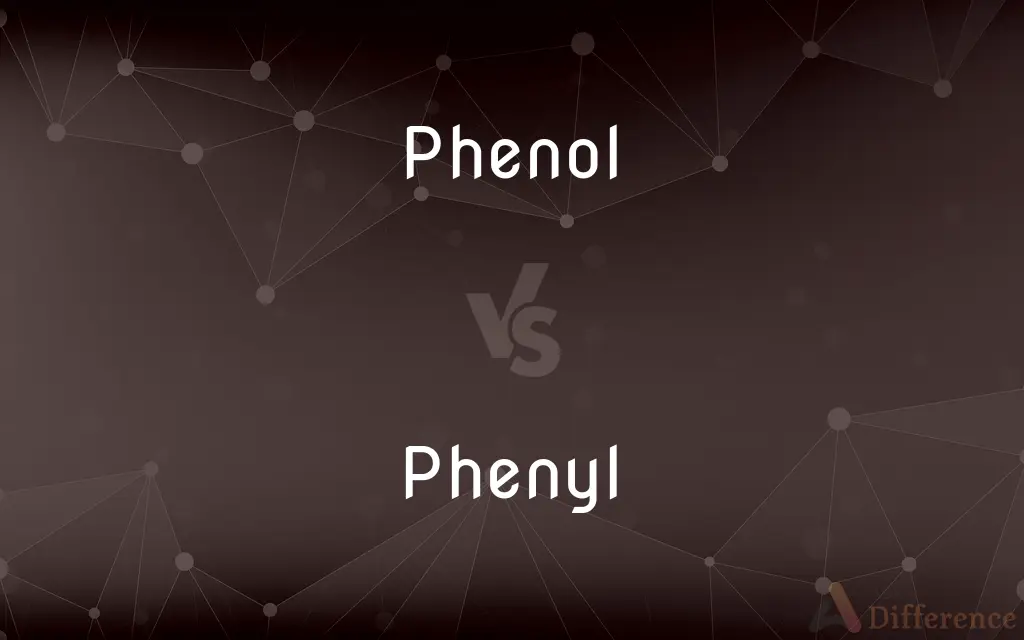Phenol vs. Phenyl — What's the Difference?
By Urooj Arif & Fiza Rafique — Updated on April 21, 2024
Phenol consists of a benzene ring bonded to a hydroxyl group, used in antiseptics and plastics; phenyl is a benzene ring minus a hydrogen, forming part of many organic compounds.

Difference Between Phenol and Phenyl
Table of Contents
ADVERTISEMENT
Key Differences
Phenol is an aromatic compound with a chemical formula C6H5OH, featuring a hydroxyl group (-OH) attached to a benzene ring. This structure contributes to its properties as both a hydrophobic and a hydrophilic molecule. On the other hand, phenyl is a structural motif in organic chemistry, represented as C6H5, essentially a benzene ring from which one hydrogen atom has been removed, making it a common substituent in various molecules.
The presence of the hydroxyl group in phenol increases its reactivity compared to benzene. Phenol is acidic and can undergo reactions typical of alcohols, such as esterification. Whereas phenyl, lacking this group, does not exhibit these behaviors but can engage in reactions typical of aromatic hydrocarbons, such as electrophilic substitution.
Phenol is soluble in water due to its ability to form hydrogen bonds with water molecules, which makes it useful in products like disinfectants and antiseptics. In contrast, phenyl groups increase the hydrophobic character of molecules they are part of, influencing the solubility and reactivity of these compounds in organic solvents.
Phenol's antibacterial and antifungal properties are leveraged in medical and cosmetic applications, reflecting its importance beyond just chemical reactivity. Conversely, phenyl is predominantly a structural component in pharmaceuticals and organic synthesis, where it impacts the activity and stability of various compounds.
Phenol can be toxic and caustic, posing risks during handling, which necessitates careful management under safety guidelines. Phenyl compounds, however, vary widely in their toxicity based on the structure of the attached molecule, affecting their safety and environmental impact.
ADVERTISEMENT
Comparison Chart
Basic Structure
Benzene ring with a hydroxyl group
Benzene ring without one hydrogen
Type of Compound
Aromatic alcohol
Aromatic hydrocarbon (group/substituent)
Solubility
Soluble in water
Generally insoluble in water
Reactivity
Acidic, can form esters
Participates in aromatic substitutions
Uses
Disinfectants, plastics
Pharmaceuticals, synthetic materials
Compare with Definitions
Phenol
A white crystalline solid that is volatile.
Phenol was originally extracted from coal tar.
Phenyl
A substituent in many pharmaceutical agents.
Phenyl is found in various medications, altering their chemical properties.
Phenol
A caustic, poisonous compound used as an antiseptic and in chemical manufacture.
Phenol is commonly found in throat lozenges as an antibacterial ingredient.
Phenyl
A radical used as an intermediate in organic synthesis.
Phenyl is involved in the manufacture of phenylalanine.
Phenol
A compound that can cause burns upon contact with skin.
Workers handle phenol with gloves due to its corrosive properties.
Phenyl
A hydrocarbon group derived from benzene by removing one hydrogen.
Phenyl groups are crucial in the structure of many drugs.
Phenol
An organic compound with the formula C6H5OH.
Phenol's hydroxyl group is bonded directly to an aromatic hydrocarbon ring.
Phenyl
An aromatic ring common in chemical nomenclature and structure.
Phenyl rings are a key feature in the structure of aspirin.
Phenol
A substance used in the synthesis of plastics and drugs.
Phenol is a precursor in the production of many pain relievers.
Phenyl
Part of the structure of many organic molecules, enhancing hydrophobic interactions.
The addition of a phenyl group can change the solubility characteristics of a molecule.
Phenol
Phenol (also called carbolic acid) is an aromatic organic compound with the molecular formula C6H5OH. It is a white crystalline solid that is volatile. The molecule consists of a phenyl group (−C6H5) bonded to a hydroxy group (−OH).
Phenyl
An aromatic hydrocarbon unit, C6H5, that can occur as a substituent in an organic compound or as an ion or radical, structurally related to benzene.
Phenol
A mildly acidic toxic white crystalline solid obtained from coal tar and used in chemical manufacture, and in dilute form (under the name carbolic) as a disinfectant.
Phenyl
(organic chemistry) A univalent hydrocarbon radical (C6H5) formally derived from benzene by the removal of a hydrogen atom, and the basis of an immense number of aromatic derivatives.
Phenol
A caustic, poisonous, white crystalline compound, C6H6O, derived from benzene and used in resins, plastics, and pharmaceuticals and in dilute form as a disinfectant. Also called carbolic acid.
Phenyl
A hydrocarbon radical (C6H5) regarded as the essential residue of benzene, and the basis of an immense number of aromatic derivatives.
Phenol
Any of a class of aromatic organic compounds having at least one hydroxyl group attached directly to the benzene ring.
Phenol
A caustic, poisonous, white crystalline compound, C6H5OH, derived from benzene and used in resins, plastics, and pharmaceuticals and in dilute form as a disinfectant and antiseptic; once called carbolic acid
Phenol
Any of a class of aromatic organic compounds having at least one hydroxyl group attached directly to the benzene ring (or other aromatic ring)
Phenol
A white or pinkish crystalline substance, C6H5OH, produced by the destructive distillation of many organic bodies, as wood, coal, etc., and obtained from the heavy oil from coal tar.
Phenol
Any one of the series of hydroxyl derivatives of which phenol proper is the type.
Phenol
Any of a class of weakly acidic organic compounds; molecule contains one or more hydroxyl groups
Phenol
A toxic white soluble crystalline acidic derivative of benzene; used in manufacturing and as a disinfectant and antiseptic; poisonous if taken internally
Common Curiosities
How does the presence of a phenyl group affect a molecule's properties?
The addition of a phenyl group to a molecule generally increases its hydrophobicity, which can affect its solubility, boiling point, and how it interacts with biological systems.
Why is phenol considered acidic?
Phenol is considered acidic because it can donate a hydrogen ion (proton) from its hydroxyl group to a base, slightly dissociating in water to form phenoxide and a hydrogen ion.
What are the safety concerns associated with phenol?
Phenol is corrosive and can cause severe burns and systemic toxicity if ingested, inhaled, or in contact with skin, requiring careful handling and proper safety measures.
What are the uses of phenyl groups in industrial applications?
Phenyl groups are integral in the synthesis of materials like polystyrene and epoxy resins, enhancing the properties of these materials, such as durability and resistance to chemical attacks.
How is phenyl used in medicine?
Phenyl groups are components of many pharmaceutical compounds, where they can influence the biological activity and metabolic stability of the drugs.
Does phenyl have any specific reactivity?
Phenyl groups themselves are relatively inert but can participate in reactions typical of benzene rings, such as electrophilic aromatic substitution.
How does phenol interact with biological systems?
Phenol can penetrate and disrupt cellular membranes, and its antibacterial properties are exploited in products like throat sprays and lozenges.
What is a common source of phenol in industrial settings?
Phenol is commonly produced from the cumene process, which involves the oxidation of cumene (isopropylbenzene) and subsequent acid-catalyzed cleavage.
Can phenyl groups be modified?
Yes, phenyl groups can be chemically modified through various reactions, including sulfonation, nitration, and halogenation, which alter their electronic and physical properties.
How does phenol's structure affect its chemical behavior?
The aromatic ring in phenol makes it stable, while the hydroxyl group is a reactive site, enabling it to undergo reactions typical of both alcohols and aromatic compounds.
What is the environmental impact of phenol?
Phenol can be toxic to aquatic life and can contaminate water sources if not disposed of properly, necessitating stringent environmental controls.
What types of compounds typically contain phenyl groups?
Phenyl groups are often found in aromatic compounds, including pharmaceuticals, dyes, and polymers, where they contribute to the stability and function of these molecules.
Is phenol naturally occurring?
Yes, phenol can be found naturally in various biological materials, such as in the degradation products of tyrosine in human metabolism and in certain plants.
What is the difference in boiling points between phenol and phenyl-containing compounds?
Phenol has a higher boiling point compared to benzene due to its ability to form hydrogen bonds; phenyl-containing compounds vary in boiling points depending on the nature and number of substituents.
Can phenol be biodegraded?
Yes, phenol can be biodegraded by certain bacteria, which use it as a carbon source, converting it into less harmful substances through metabolic processes.
Share Your Discovery

Previous Comparison
Woman vs. Women
Next Comparison
Judaism vs. SikhismAuthor Spotlight
Written by
Urooj ArifUrooj is a skilled content writer at Ask Difference, known for her exceptional ability to simplify complex topics into engaging and informative content. With a passion for research and a flair for clear, concise writing, she consistently delivers articles that resonate with our diverse audience.
Co-written by
Fiza RafiqueFiza Rafique is a skilled content writer at AskDifference.com, where she meticulously refines and enhances written pieces. Drawing from her vast editorial expertise, Fiza ensures clarity, accuracy, and precision in every article. Passionate about language, she continually seeks to elevate the quality of content for readers worldwide.














































